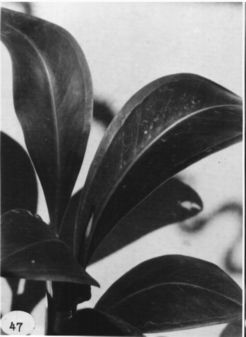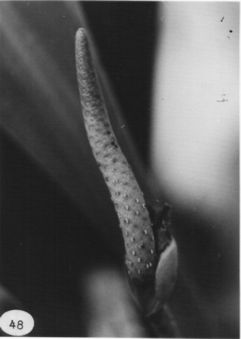





Anthurium crassilaminum Croat, sp. nov.
TYPE: Panama. Code: along road to CoclŽcito. near Continental Divide, Hammel 7232 (MO 2817155, holotype; B, C, K, PMA, US, isotypes; Live at MO).
Planta epiphytica aut epipetra; cataphyllum subco-riaceum persistens in reticulum fibrarum; petiolus sul-catus, 3-17 cm longus; lamina coriacea, oblongo-oblanceolata ad raro anguste elliptica, costa conspicue arcuata, 25-38 cm longa; 10-12.5 cm lata, pagina inferiore dense glanduloso-punctata; inflorescentia erecta; pedunculus teres, 10-42 cm longus; spatha subcoriacea, viridis, lanceolata ad oblonga, 3.5-5 cm longa. 1-3 cm lata; spadix viridis lavandulascens, 5-6.5 longus; baccae ignotae.
Epiphytic or epipetric herb; stems less than 15 cm long, 1.5-2.5 cm diam.; roots moderately dense, spreading or descending, 2-3 mm diam.: cataphylls moderately thick, ca. 4 cm long. narrowly acuminate at apex (with short subapical apiculum), drying reddish brown, weathering into reticulate fibers.
LEAVES erect; petioles 3-17 cm long, shallowly and bluntly sulcate. rounded abaxially; geniculum 1-2 cm long: blades coriaceous, oblong-oblanceolate to rarely narrowly elliptic, markedly arched along midrib, short-acuminate at apex, acute to attenuate at base-25-38 cm long, 10-12.5 cm wide. broadest just above middle or rarely at middle; upper surface semiglossy, eglandular. lower surface matte, densely glandular-punctate; midrib broadly raised at base, narrowing at middle, diminishing and sunken at apex above, broadly raised below, flat at apex; primary lateral veins 6-10 per side, departing midrib at 40-60° angle, clearly visible on new leaves, less conspicuous on older blades, merely etched to weakly sunken above, flat to prominulous below, straight to collective vein; interprimary veins scarcely visible above and below; collective vein arising from the base, 7-10(-13) mm from margin, etched to weakly sunken above, prominulous below.
INFLORESCENCE erect, equalling or longer than leaves; peduncle 10-42 cm long, 5-7 mm diam., terete, tinged red-violet near base, usually 2-3 times longer than petioles; spathe subcoriaceous, green, lanceolate to oblong, 3.5-5 cm long, 1-3 cm wide, broadest below middle, obtuse to rounded and cuspidate at apex, acute at base, decurrent ca. 2.5 cm; spadix green, becoming pale lavender (B & K. Blue-purple 7/7.5), faintly scented of orange peels from midmoming to midaftemoon before stamens emerge, 5-6.5 cm long, 7-10 mm diam. at base, 3-4 mm diam. at apex; flowers 4-lobed, 2.3-2.9 mm long, 2.9-3.5 mm wide, the sides sigmoid, 4÷5 flowers visible in the principal spiral, 9-10 flowers visible in the alternate spiral; tepals matte, minutely papillate, lateral tepals 1.3-1.7 mm wide, the inner margin convex, the outer margin conspicuously 3-4-sided; pistils emergent, not raised, pale green, becoming pinkish; stigma ellipsoid, 0.2 mm long, dark purple; lateral stamens emerging from the base, retracting before alternates emerge; anthers reddish, ca. 0.5 mm long, ca. 0.7 mm wide; thecae ovoid-ellipsoid, slightly divaricate; pollen lavender.
INFRUCTESCENCE not known. Figs. 47 and 48.
Anthurium crassilaminum is endemic to Panama and is known only from the type collection in Code Province at ca. 850 m in premontane rain forest.
The species is in section Porphyrochitonium and is distinguished by its coriaceous, oblong-lanceolate, markedly curved blades and the tapered lavender spadix. It is most closely related to Anthurium curvilaminum, which has similar coriaceous, curved blades. The latter differs, however, in that it has a more cylindroid, scarcely tapered spadix that is darker violet purple, has eight to 13 flowers visible in the principal spiral (versus 4-5 in A. curvilaminum), and has narrowly acuminate cataphylls (versus narrowly rounded with a subapical apiculum in A. curvilaminum). In addition, A. crassilaminum differs in having stamens that retract beneath the tepals and flowers that have a related but distinctly different aroma. The stamens of A. curvilaminum persist above the tepals after anthesis.
 |
 |
Panama CoclŽ:, 3 May 1979, Barry Hammel 7232 (CAS, F, MEXU, MO, NY,
SEL, WU).
Panama CoclŽ: 500 m,, 3 May 1979, B. Hammel 7232 (MO).
.